

An icon turns


Commemorating 50 years of sports, culture and politics from ‘the
greatest building in the history of mankind’



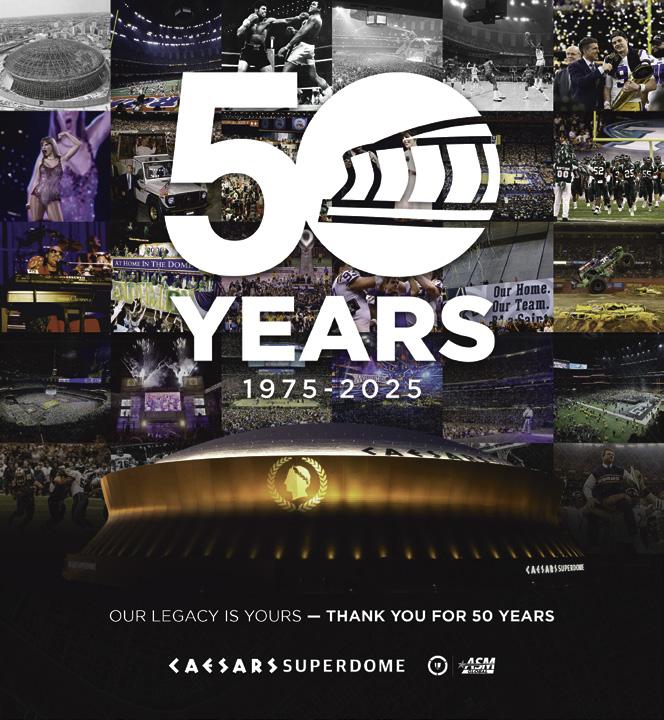
John McKeithen was right. The Superdome is the greatest stadium ever built.
JEFF DUNCAN | SPORTS COLUMNIST
We haven’t done a lot right in New Orleans over the last 50 years. But the Superdome is certainly one of our city’s greatest achievements, something we can boast about with unabashed civic pride.
The Superdome is not only one of the most iconic buildings in the world; it also is arguably the greatest stadium ever built. An architectural wonder and engineering marvel since opening in 1975, the Dome stands as a monument to the ambition, ingenuity and creativity of our state.
In stumping for its construction in the late 1960s, Louisiana Gov. John McKeithen boldly predicted that the Superdome would be “the greatest building in the history of mankind.” A half-century later, the Dome hasn’t just delivered on those grand expectations. It has exceeded them.
In a city that has never minded living in the past, the Superdome thrust New Orleans into the future, transforming the city’s image, psyche and skyline.
“It glistens like a giant dewdrop diamond on the throat of New Orleans, an awesome skyline-crowding structure that is beyond tomorrow,” Houston Chronicle columnist Stan Redding wrote after touring the stadium in 1975.
Others echoed his sentiments:
“Houston’s Astrodome compares to the Superdome like Lindbergh’s Spirit of St. Louis to a 747 jumbo jet. It’s the damndest thing I ever saw,” wrote Ed Comerford of Newsday after touring the stadium before its opening in 1975.
The New York Times boldly proclaimed, “The Louisiana Superdome will make all other stadiums in existence as obsolete as Rome’s Coliseum.”
And Jep Cadou opined breathlessly in the Saturday Evening Post, “The State of Louisiana has come mighty close to erecting a Garden of Eden for the delectation of its citizens and visitors in New Orleans. (It) will befuddle our speculative friends of the future, the archaeologists.”
Standing 27 stories high, weighing 300,000 tons and covering 13 acres, the Superdome’s massive size required an underground forest of 3,000 pilings, each 160 feet long and 10 inches in diameter, to support it. The building’s multi-purpose functionality allowed it to showcase events of all kinds, from monster truck competitions and Mardi Gras balls to
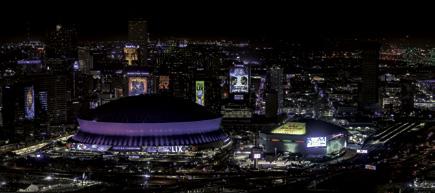
graduation commencements and home and garden shows.
The Superdome instantly became a magnet for major sporting events and a major economic generator for the state, validating the vision of the dreamers who championed its construction. It put New Orleans on the map, fueling the city’s tourist business and bolstering its reputation as a destination location.
Over the years, the Superdome has played host to popes and pop stars, presidents and professional sports legends, while providing the stage for some of the most memorable moments in sports history.
Muhammad Ali, Tom Brady and Michael Jordan — three of the greatest athletes of all time — competed and won championships in the Superdome. Can any other venue in the world make such a claim?
Joe Burrow, Carmelo Anthony, Brett Favre, Anthony Davis, Jon Montana, Terry Bradshaw, Len Dawson and Roger Staubach also were crowned champions in the Dome, while some of sports’ greatest mentors and leaders — Nick Saban, Eddie Robinson, Mike Krzyzewski, Bill Belichick, Dean Smith, Don Shula, Bob Knight, Joe Paterno, John Calipari and Bear Bryant, among others — have coached there.
The roster of entertainment stars who have per-
formed under its iconic white roof includes Frank Sinatra, Mick Jagger, Whitney Houston, Billy Joel, Willie Nelson, Garth Brooks, Prince, Beyoncé and Taylor Swift.
In its 50-year existence, the Superdome has generated billions of dollars in direct and indirect spending for the region. It also has generated hundreds of jobs, revitalized the Poydras Street business corridor and attracted professional sports to the city.
Today, the Superdome stands as the most important capital project in Louisiana history and the city’s most valuable commodity other than the French Quarter.
While its domed peers in Houston, Detroit, Indianapolis, Minneapolis and Seattle have long since become obsolete and demolished, the Superdome has endured the test of the time and remains a stateof-the-art facility, recently hosting its record eighth Super Bowl.
For New Orleanians, the Dome is more than just a building. It’s a beloved landmark and cultural icon that, in times of need, has also sheltered citizens during major tropical storms. Most of all, the Superdome has served as a communal living room for the city, a gathering place for locals to share joyous celebrations and make indelible memories.
It’s the best $160 million Louisiana ever spent.
The New Orleans skyline and the Caesars Superdome, the site of the NFL Super Bowl LIX, shot from a Jefferson Parish Sheriff’s Office helicopter by Caitlyn Reisgen, Thursday Feb. 6, 2025.


From unforgettable games to concerts, there’s no place quite like the Superdome
ROD WALKER | SPORTS COLUMNIST
The ticket stub from my first ever trip to the Superdome is still tucked away in my high school memory book.
Section 628. Row 16. Seat 3.
Truth be told, I don’t even remember who won that Dec. 6, 1987, game between the New Orleans Saints and Tampa Bay Buccaneers.
All I remember is that my next-door neighbor — Judge A.J. Peyton — loaded up his Cadillac with me, his sons Edd and Gerald and his granddaughter Ruthie and made the drive down I-55 South to our first NFL game.
My only recollection of the game itself was a rookie named Vinny Testaverde, who had won the Heisman Trophy a year before, making his first start for the Buccaneers. For the purpose of this column, I looked it up and saw that the Saints won 44-34 that day.
But for a teenager from Mississippi, the final score wasn’t important.
What was important was that I was sitting inside one the most iconic venues in the world. Little did I know at the time that this place would become my office on Sundays.
It was called the Louisiana Superdome back then, long before Mercedes-Benz and later Caesars spent millions and millions of dollars to have their name on the place.
This building was immaculate, especially to a wide-eyed kid from Mississippi who had never seen football played indoors.
The three hours spent that Sunday was just the precursor of many more Dome memories. Some of those memories were made as I watched from an 18inch TV screen from home three hours away. Others
were in person from a press box where the temperatures often leave me wondering if I’m in New Orleans or Green Bay.
And there are those rare occasions when I get to sit in the Dome and just be a fan.
In 1982, I watched from home as Michael Jordan buried a jumper to beat Georgetown for the NCAA title. Two years before that, I watched on television as Roberto Duran said “No Mas” in his welterweight fight against Sugar Ray Leonard.
In early July, I watched as thousands of fans at Essence Fest figuratively said “No Mas” and headed towards the exits long before Lauryn Hill finished her set at 3:37 a.m.
It made for a long exhausting night. I could have used a timeout, but like Chris Webber and the Michigan Wolverines 32 years earlier, I didn’t have one.
STAFF PHOTO BY CHRIS GRANGER
STAFF PHOTO BY VERONICA DOMINACH
So I endured until the end.
It was worth the wait, which is usually the case when it comes to this place.
Saints fans had to wait 21 seasons from the birth of the franchise in 1967, including the first eight seasons playing at Tulane Stadium, to get their first taste of the playoffs. They waited another 13 years to get a playoff win. And then another nine years to see “pigs fly and hell freeze over” as Garrett Hartley’s 40-yard field goal soared through the uprights to punch the Saints’ ticket to their first and only Super Bowl.
Some cheered.
Some cried.
Just like they had done on that magical night in September of 2006 when Steve Gleason stretched out to block a punt symbolizing the rebirth of a city that a year earlier had felt the devastation of Hurricane Katrina. The home to the New Orleans Saints all of a sudden became the home to the homeless, the thousands of people who were affected by the worst natural disaster this country had ever faced. The images from the Dome told the rest of the world just how dire things were in the city.
In typical New Orleans fashion, the city bounced
Super Bowl LIX crews resumed building tents, barricades, and other related setups around the Caesars Superdome and Poydras Avenue in New Orleans on Thursday, January 23, 2025, days after a major snowfall covered south Louisiana.
back. And the city’s most recognizable venue bounced back, too.
Drew Brees rewrote the NFL record books, doing for the Saints offense what Rickey Jackson, Sam Mills, Vaughan Johnson and Pat Swilling once did for the Saints defense. They were the Dome Patrol, a quartet of linebackers who made Who Dats remove those paper bags from their heads and stick their chests out just a little bit further.
The Dome Patrol made Saints fans start dreaming big. And when it comes to dreaming big, there’s no place quite like the Dome.
Just ask every high school football player in the state of Louisiana. Yeah, they all love playing under the Friday night lights in their respective hometowns. But the ultimate high school football games are played in the Dome with a state championship on the line in December.
Or ask any fan of Southern University or Grambling, the two schools that play on the Saturday after Thanksgiving every year in the Bayou Classic. Bragging rights for the next 365 days are at stake when the Jaguars and the Tigers clash. At some point, Southern’s Human Jukebox will play the tune “Do What You Wanna,” which seems fitting when I think back on some of the strange moments witnessed in the Dome.
Do what you wanna is what the refs did that January afternoon in 2019 when the referees decided not to throw a flag on what should have been an obvious pass
interference in the NFC championship game between the Saints and Los Angeles Rams.
There was the night the Undertaker’s 21-match winning streak at WrestleMania came to an end with a loss to Brock Lesnar.
There have been epic Sugar Bowls, including ones with a mascot feud between University of Texas steer, Bevo, and the University of Georgia’s bulldog, Uga.
There have been memorable Super Bowls with epic halftime performances, including one that was followed up by the lights going out in the Dome and interrupting the third quarter of Super Bowl XLVII. The game was put on pause for 34 minutes.
Eventually, the lights came back on.
There were more Superdome memories to be made.
A year later, Prince performed at Essence, his final performance in New Orleans.
It was a night I’ll never forget, which is often the case every time I step foot in the Dome.
My first time was a football game in 1987. The most recent time was the final night of Essence Fest 2025.
The final song of the night was Boyz II Men singing their hit “End of the Road.”
Essence Fest had come to an end.
But the Superdome, far from the end of its road, is still going strong.
Happy 50th!!!
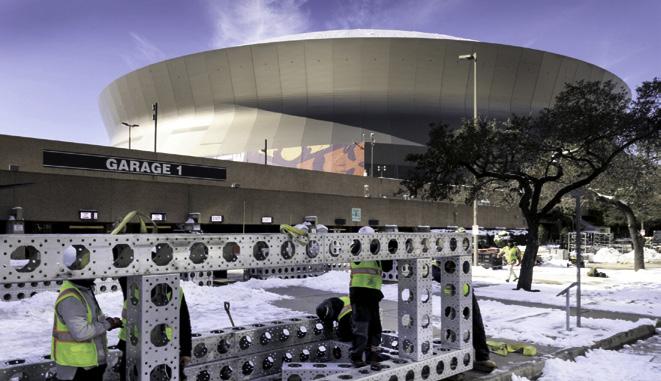
STAFF PHOTO BY CHRIS GRANGER
The Superdome’s changing lights celebrate the city.
Here’s a look behind the scenes.
DOUG MACCASH | STAFF WRITER
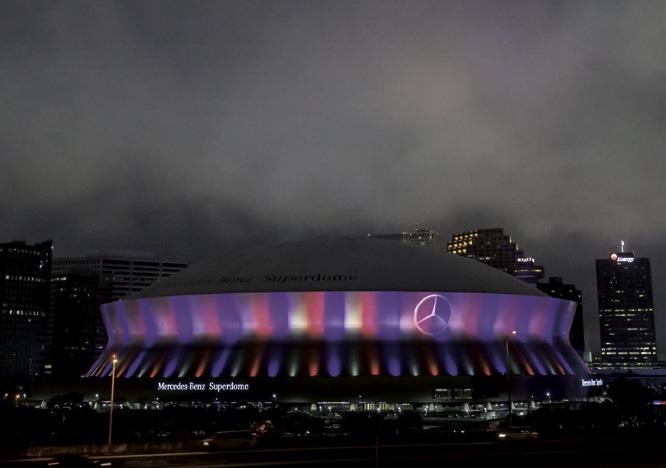
From the time its massive skeleton rose over Poydras Street, the Louisiana Superdome –now known as the Caesars Superdome – was a centerpiece of the Crescent City Skyscape. Its mushrooming minimalist architecture couldn’t be missed. Except maybe when the sun went down.
Back in 2010, as the Champions Square plaza was being installed beside the great arena, Gary Solomon Jr., CEO of the Solomon Group design firm, and the late architect Alan Eskew noticed something. Despite its massiveness, at night, Solomon said, “the Dome vanished into the night sky.”
Solomon and Eskew set out to change that. Soon the Superdome would be illuminated with a complex high-tech lighting system that jazzed up the downtown cityscape after dark like never before.
The enormous Dome had been custom lit at least twice, for the 2002 Super Bowl and for the wind-blasted arena’s resurrection after Hurricane Katrina on Sept. 25, 2006. Those temporary illuminations provided inspiration, but the permanent
lighting system that Solomon and Eskew envisioned would go further.
On Oct. 20, 2011, a huge crowd assembled to watch Saints owners Tom and Gayle Benson throw the switch that ignited the new Superdome lighting system, splashing the metallic walls of the building with a shifting light show synchronized to music.
As reported in The Times-Picayune at the time, the new $1.6 million illumination was produced by “26,000 LED lights in 288 fixtures that are capable of reproducing every color of the rainbow on all 96 concave aluminum panels that ring the building’s exterior.”
Of course, Solomon said, the new lights set the Dome aglow, but they did more than that. “There was such energy inside the Dome that we wanted to take that outside,” Solomon said.
Soon the Superdome staff began keying the exterior colors to sporting events, concerts, and special tributes.
The Dome was lit in purple for Prince’s appear-
ance at Essence Fest in 2014. It has been turned pink during breast cancer awareness month, blue in tribute to NOPD officers who died in the line of duty, green for Tulane University, the colors of the flag for a presidential visit, Christmas colors and on and on.
As Solomon put it, with the new lighting system, the Dome became a sort of community beacon that “speaks to the moment.”
Solomon said that eye-catching, coded architectural lighting has become more common over the past 14 years, but when it first appeared on the Dome, it was a game-changer. Now, he said, largescale parts of the city’s architecture and infrastructure, such as the awning over the World War II Museum and the Crescent City Connection have followed suit. “The Dome,” he said “may have influenced other architecture.”
Solomon said that in 2021, when the arena was rebranded the Caesars Superdome, the white roof of the structure was lit for the first time to allow the company logo to be seen from the air at night.
STAFF PHOTO BY DAVID GRUNFELD





















Life at 50
The legendary Superdome by the numbers
ZACH EWING | STAFF WRITER
The Superdome turns 50 this month, and while that’s the big number, there’s plenty of ways to tell the story of the famous stadium using other figures.
8
Super Bowls
hosted by the Superdome, two more than any other stadium
13
times the college football national champion has been crowned at the Superdome, starting with Pitt in the 1977 Sugar Bowl and including five BCS or CFP national title games

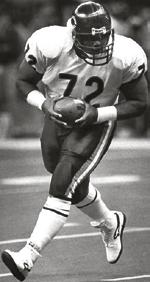

31
years of the Essence Music Festival at the Superdome
Reported attendance for a Rolling Stones concert on Dec. 5, 1981, known for decades as the world’s largest indoor concert
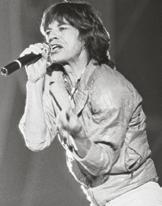
87,500
4
NFL stadiums older than the Superdome (Lambeau Field, Soldier Field, Arrowhead Stadium, Highmark Stadium)
400,000
Approximate square footage of aluminum that makes up the Superdome roof
1
680
diameter of the Superdome, in feet, making it the largest fixed dome structure in the world. It sits on a plot of 52 acres, and a walk around the outside of the Dome is 0.65 miles.
sitting presidents to attend a Super Bowl: Donald Trump at this year’s game in the Superdome; Trump also attended the 2020 College Football Playoff championship between LSU and Clemson
273 height of the Superdome, in feet

Current maximum seating capacity for a football game. For basketball, it’s 67,500, and for concerts, 83,000.

503 69,000
229

LED lights in the Superdome’s exterior lighting system
High school state football championship games in the Superdome, starting in 1981 and played there every year except for 2005 and 2020.
NFL games played at the Superdome: 384 Saints regular-season games, 97 Saints preseason games, 14 Saints playoff games and eight Super Bowls

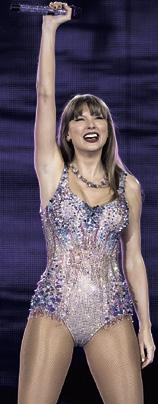
6
26,000 191,000
Times in 50 years the Bayou Classic has been held at the Superdome. The only exceptions were the 2005 game in Houston and the 2021 game in Shreveport.

30,000
Peak estimated evacuees in the Superdome following Hurricane Katrina
52
Escalators in the Superdome, along with 22 elevators. The longest escalator is 120 feet.
Men’s Final Fours at the Superdome, from Michael Jordan’s coming-out party in 1982 to Mike Krzyzewski’s farewell in 2022
Three-day attendance for Taylor Swift concerts at the Superdome in 2024, the highest-attended concert series in the stadium’s history



As the Superdome

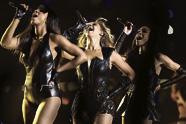
turns 50, we look back at the biggest Dome concerts of all time
DOUG MACCASH | STAFF WRITER
The Allman Brothers, etc., 1975
In addition to great music, the concert also generated controversy. The Allman Brothers later sued the concert promoters, the Superdome and the ticket-taking company for $1.3 million, claiming the band did not receive money for more than 25,000 tickets sold.
The Times-Picayune’s John Alan Simon reported that the audience numbered 80,000. A 1979 Times-Picayune story lists the attendance as 55,000. Day of Rock & Roll, 1979, 1980, 1981
The Days of Rock & Roll concerts featured Sammy Hagar, Nazareth, Van Halen, Boston, Heart, Blue Oyster Cult, and the Granati Brothers in 1979. Eagles, Foreigner, Cheap Trick, and Christopher Cross played in 1980. And REO Speedwagon, Ted Nugent, Heart, and Foghat played in 1981.
The Times-Picayune’s Kelly Tucker reported that the audience reached 63,800 in 1979.
Budweiser Superfest, 1979 to 1999
The traveling R&B and soul concerts drew what Times-Picayune reporter Bunny Matthews described as “absurdly gigantic” crowds to the Louisiana Superdome. No wonder (pardon the pun), since the 1982 show, for example, included Stevie Wonder, Maze, Quincy Jones, Ashford and Simpson, and Kool and the Gang.
The Rolling Stones, 1981
A total of 87,500 fans attended the concert, including Pat Adams of the tennesseeconcerts. com website, who wrote: “The opening bands were the Neville Brothers, followed by George Thorogood and The Destroyers. Both acts were good. They flashed up on the sign that the concert had set a record for the largest indoor concert ever held.” The Stones also played the Dome in ‘78 (with 80,173 in attendance), ‘89 and ‘94.
Prince, 1985
The late pop phenomenon reportedly drew 50,000 fans to the New Orleans stop on his “Purple Rain” tour.
Frank Sinatra, Sammy Davis Jr., and Liza Minnelli, 1989
New
Kids on the Block, 1990
As The Times-Picayune wrote: “The Aug. 23 New Kids on the Block concert has been moved from the (8,933-seat) Lakefront Arena to the Superdome to accommodate “excessive” ticket demand ... all tickets for the sold-out Lakefront Arena concert will be honored at the Superdome, and another 20,000 tickets will go on sale.”
Guns N’ Roses N’ Metallica, 1992
The pair of heavy metal juggernauts must have sold well. The Times-Picayune’s Scott Aiges reported that one fan stood in line 43 hours to secure a seat.
Paul McCartney, 1993
Pink Floyd, 1994
Bette Midler, 1994
U2, 1997
The Blues Brothers, ZZ Top, James Brown, 1997 Actors Dan Aykroyd, John Goodman, and James Belushi in the roles of the Blues Brothers, at the Super Bowl XXXI halftime show. Attendance: 72,301.
Janet Jackson, 1998
George Strait, 1998 and 1999
The man whose exes live in Texas played the Dome in 1998 drawing 43,000, then again in 1999, drawing a respectable 34,000 according to figures provided by the Dome management.
Cher, 1999
Cher, with help from Cyndi Lauper, turned back time for 13,000 fans.
Note: The Smoothie King Center, then known as The New Orleans Arena, was completed in 1999, providing a second, smaller concert venue at roughly the same site as the Louisiana Superdome.
NSYNC, 2000
Britney Spears, 2000
Keith Spera reported Spears’ Superdome sales reached 30,000.
U2, Super Bowl XXXVI halftime show, 2002 U2’s stirring tribute to the victims of the September 11 terrorist attacks. Attendance: 72,922.
Luther Vandross at Essence Fest, 2002 Essence Festival fills the Superdome annually with attendees from across the country. Since the fest takes place over a three-day period, with events in the Ernest N. Morial Convention Center as well as the Dome, it’s difficult to arrive at an exact attendance figure for a single concert. But it’s probably fair to say that a good percentage of the 2002 audience, reported by the Dome management to be 138,000 strong, was on hand for Luther Vandross.
Kenny Chesney and Tim McGraw, 2012
The country comrades told 35,000 fans to do whatever it took to make them feel like rock stars, according to Superdome representatives.
Beyonce and Destiny’s Child, Super Bowl XLVII halftime show, 2013
Attendance: 71,024.
One Direction, 2014
Beyonce and Jay Z, 2014
The pop music power couple played to 42,000.
Prince at Essence Fest, 2004 and 2014
Prince’s Saturday concert certainly attracted a large share of the approximately 140,000 weekend Dome attendees in 2004. Same could be said for his Essence appearance in 2014.
The Rolling Stones, 2019
In 2019, the Rolling Stones most recent appearance at the Dome drew 40,000.
Beyonce in 2016 and 2023
In 2016 Beyonce sold 45,000 tickets to her Superdome show, which set a record as the highest-grossing, single concert with $5.3 million in ticket sales. Beyonce’s 2023 Superdome appearance had an unofficial, estimated attendance of 50,000.
Taylor Swift in 2024
In 2024, Taylor Swift’s three-night stand at the Superdome, drew an average of 64,000 fans per show, totaling 191,000 fans overall, setting official revenue and multi-day attendance records. According to Dome representatives, 80% of the ticket sales went to out-of-state buyers.

50 years, one rivalry, countless memories:
The Bayou Classic’s enduring role in the Superdome’s success
By Amanda McElfresh amcelfresh@theadvocate.com
This article is brought to you by the organizers of the Bayou Classic.
When the Caesars Superdome was in the planning stages, three major events were instrumental in convincing lawmakers to build the stadium: Saints games, the Sugar Bowl, and the Bayou Classic.
Among the “Big Three,” the Bayou Classic stands out. This annual rivalry between Grambling State University and Southern University made history in 1975 as the first college football game played in the Superdome.
Over the years, the game has delivered unforgettable moments: Southern’s 14-7 win in 1979 that ended Grambling’s five-game winning streak, a 31-30 Southern victory in 1991 that marked the first nationally televised HBCU football game, and the 2016 clash of two then-undefeated powerhouses, where Grambling lit up the scoreboard with a 52-point victory.
“The Superdome is so tied to the
game’s legacy,” said Dottie Belletto, founder and CEO of NOCCI, a leading event marketing and logistics firm. “We’re the only classic that is played every year in an NFL stadium and airs on national television every year. I don’t know that you would see the numbers and visibility the Bayou Classic has without the Superdome.”
With the Superdome as its cornerstone, the Bayou Classic is a multi-day cultural celebration. From events like a parade along Canal and Poydras streets to the Battle of the Bands, the weekend draws thousands of fans, alumni and supporters.
“It’s almost like a huge family reunion,” Belletto said. “You see families from split households, where some cheer for Southern and some cheer for Grambling. We’ve had parents who did not attend either school who bring their children so they can experience the HBCU culture. It’s always fun to see different generations who enjoy being together throughout the weekend.”
The 52nd annual Bayou Classic will take place on Saturday, November 29, 2025.




Congratulat ions to the superdome on 50 iconic years.
BayouClassic is proudtobe part of itsstory...andits soul .



How the Superdome got its name in the 1960s
The name Superdome came from the building’s chief promoter, visionary businessman Dave Dixon, who is responsible for so many chapters of the history of the building now called the Mercedes-Benz Superdome.
On Nov. 4, 1965, Dixon joined New Orleans Mayor Victor Schiro in announcing plans for a $24 million multipurpose, enclosed, air-conditioned stadium. The Houston Astrodome, the world’s first domed stadium, had opened seven months earlier.
Peter Finney’s Nov. 5, 1965 article in The StatesItem explained that “fifty percent of the construction costs have been pledged … provided the city is granted a franchise in either the National or American Football League.” That happened one year later.
In 1965, Dixon predicted the stadium would revolutionize sports in the city. “It will be an all-purpose stadium for use by the community, not just a pro football team,” he said, envisioning a home not just for football but also baseball, basketball, boxing and track. In a Feb. 3, 1966 Times-Picayune article, Gov.
John McKeithen, an enthusiastic proponent of the project, proclaimed “this stadium will be the finest in the world.”
In his 2008 book, “The Saints, the Superdome and the Scandal: An Insider’s Perspective,” Dixon explained the history of the building’s name, calling it an “easy” choice. “I selected the name early on, right at the beginning of our stadium and (NFL) franchise efforts,” he said. “Actually, I chose the name while the Astrodome was a mammoth hole in the ground over in Houston. I considered only two names, Superdome or Ultradome. To my ear, ‘Superdome’ sounded far better than ‘Ultradome.’”
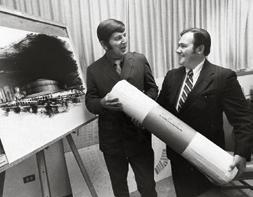
Dixon points out that his use of the word “super” even came before the first Super Bowl, which was played in 1967.
After years of construction delays and a price tag that ballooned to $163 million, the Louisiana Superdome opened to rave reviews on Aug. 3, 1975. In
Horance H. Hayden, right, chief of design, presents completed drawings, totaling 450 sheets of paper and representing the work of about 300 people through 30 months, to Dave Dixon, on Oct. 30, 1970.
July of 2021, Caesars Entertainment Inc. reached an agreement with the Saints to purchase the naming rights to the Superdome.
– Blake Pontchartrain



in the of the

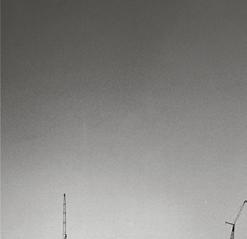
biggest Superdome the moments history
The Caesars Superdome is in its 50th year after opening in 1975, and there are plenty of moments over the last five decades that are worth remembering.
These are 30 moments that stand among the most prominent in the history of the Superdome.
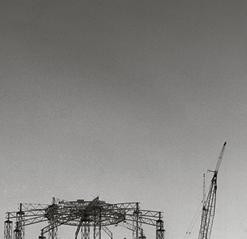


From politics to sports, the Superdome has often been the center of attention over the last five decades.
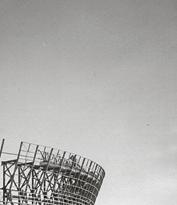

STAFF REPORT
Superdome groundbreaking
The construction of a major domed stadium in Louisiana began nearly five years after the NFL awarded a franchise to the city of New Orleans. Louisiana businessman Dave Dixon first pitched the idea to Louisiana governor John McKeithen, who promised that a domed stadium would be built.
Louisiana legislators approved the dome’s construction by the largest margin in state history on Nov. 8, 1966, seven days after NFL commissioner Pete Rozelle awarded the league’s 25th franchise to New Orleans. The dome project faced delays but eventually broke ground in 1971 in downtown New Orleans, taking nearly four years to complete.
Superdome opens
The Louisiana Superdome became the new home for the New Orleans Saints for the 1975 NFL season after opening in August. The first Saints game played in the new indoor stadium was a preseason contest against the Houston Oilers on Aug. 6.
The massive steel structure became the largest fixed dome structure in the world, which remains true to this day. The Superdome took the place of Tulane Stadium as a host site of Super Bowls and major college football games. The Dome has hosted the Sugar Bowl ever year since 1975 as well as the Bayou Classic between Southern University and Grambling State.
First Sugar Bowl
The Sugar Bowl had been played in New Orleans every year since 1935 at Tulane Stadium, but it would have a new home for the first time in over 40 years with the Louisiana Superdome becoming the new permanent host site for the highly anticipated postseason college football matchup.
The first Sugar Bowl in the Superdome was between SEC champion Alabama and Penn State, a Division I Independent at the time. Coached by the legendary Bear Bryant, Alabama won a low-scoring 13-6 contest to finish the season as the No. 3-ranked team in the country with an 11-1 record.
Super Bowl XII
The first Super Bowl played in the Louisiana Superdome featured the NFC champion Dallas Cowboys and the AFC champion Denver Broncos.
Super Bowl XII saw the Cowboys lead from start to finish in a dominant 27-10 victory over the Broncos. Dallas quarterback Roger Staubach beat his former teammate in Broncos QB Craig Morton. Staubach passed for 183 yards and one touchdown in the win, which included four Dallas interceptions of Morton. The Super Bowl victory was the second in Cowboys franchise history and their second in New Orleans after winning their first title at Tulane Stadium.
Muhammad Ali defeats Leon Spinks
The heavyweight boxing bout deemed “September to Remember” featured Muhammad Ali and Leon Spinks as Ali looked to become the first three-time undisputed heavyweight world champion in front of a crowd of 65,000 people at the Louisiana Superdome.
Ali was defeated by Spinks in their first fight earlier that year in Las Vegas, but Ali avenged his loss to Spinks via a 15-round unanimous decision in New Orleans to become the heavyweight world champion once again. The famous fight was one of the last of Ali’s storied career, as he was 36 years old at the time.
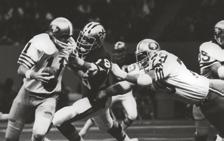

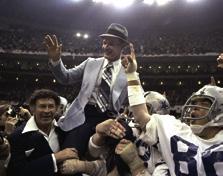




Sugar Ray Leonard defeats Roberto Duran
(No Mas fight)
Roberto Duran defeated Sugar Ray Leonard in a unanimous decision in Montreal just five months prior to the two being matched up again at the Louisiana Superdome on November 25, 1980, with the WBC welterweight championship on the line. Duran had taken the championship from Leonard, but Sugar Ray reclaimed the title with a dominant performance in New Orleans. Leonard landed several punches to Duran, who turned to the referee in the eighth round and supposedly said, “no mas” before bowing out of the fight. Duran’s surrender resulted in an eight-round TKO for Leonard.
Super Bowl XV
Super Bowl XV between the Oakland Raiders and Philadelphia Eagles was the second Super Bowl played in the Louisiana Superdome.
Raiders quarterback Jim Plunkett had a rollercoaster NFL career up to that point, but he found success early on against the Eagles after connecting with wide receiver Cliff Branch for a two-yard touchdown on the Raiders first drive. The Raiders defense made life tough on Eagles quarterback Ron Jaworski, with Raiders linebacker Rod Martin intercepting Jaworski a Super Bowlrecord three times. The result was a 27-10 Raiders victory – their second Super Bowl win in franchise history.
Rolling Stones concert in front of 87,500 fans
The Rolling Stones played in front of 87,500 people at the Louisiana Superdome as part of “The American Tour 1981” that saw the band visit various stadiums and arenas throughout the U.S. to promote their new album “Tattoo You.” Tickets to the concert in New Orleans were under $20, which included The Neville Brothers, George Thorogood and The Destroyers as opening acts. The attendance number broke the record for the most attended indoor concert in the world, which stood for 33 years until George Strait played in front of over 100,000 people at AT&T Stadium in Dallas in 2014.
NCAA Tournament title game
The first men’s NCAA Final Four at the Louisiana Superdome featured plenty of future NBA stars in the championship game between North Carolina and Georgetown.
North Carolina was led by James Worthy, Sam Perkins and freshman Michael Jordan. On the Georgetown side, Patrick Ewing and Eric Floyd were among the standouts. Trailing by one point in the closing seconds, North Carolina coach Dean Smith called a timeout and drew up a play for Jordan, predicting that Georgetown would heavily defend Worthy, who had a game-high 28 points.
North Carolina won 63-62 after Jordan nailed a jump shot with 17 seconds remaining.
Super Bowl XX
The third Super Bowl at the Louisiana Superdome saw the NFC champion Chicago Bears dominate the AFC champion New England Patriots.
The Bears had an elite defense coached by legendary defensive coordinator Buddy Ryan, and they came up with seven sacks while holding the Patriots to just 10 points. Bears head coach Mike Ditka made the controversial decision to hand the ball off to William “The Refrigerator” Perry for a 1-yard touchdown late in what ended up a 46-10 blowout instead of giving legendary running back Walter Payton a shot at the end zone, a decision Ditka later said was “a gross mistake.”
Papal visit
Pope John Paul II visited New Orleans on Sept. 11-13, 1987, as part of a 10-day trip to the United States.
He spent 36 hours in the city after Shepherd One, the pope’s jet, touched down in Louisiana on Sept. 11.
The pope visited St. Louis Cathedral for a reception with clergy members. He then traveled in his “Popemobile” to the Superdome, where he spoke to Black Catholic leaders and Catholic educators. He also spoke at a youth rally on the floor of the Dome, featuring a mini-Mardi Gras parade and the St. Augustine Marching 100 band.
Republican National Convention
New Orleans again showed the world that it knows how to put together a party, hosting the 1988 Republican National Convention at the Superdome.
Local leaders worked for months to prepare the city for opening night, which included a speech from President Ronald Reagan at the Dome.
Vice President George H.W. Bush, the presumptive nominee, hadn’t revealed his running mate. He surprised many when he introduced Indiana Sen. Dan Quayle as his vice presidential pick at a rally at Spanish Plaza.
Bush’s speech at the Superdome is remembered for a line that later contributed to his 1992 defeat: “Read my lips, no new taxes.”
Super Bowl XXIV
The Denver Broncos sought redemption in Super Bowl XXIV in the Superdome after losing in their previous three Super Bowl appearances, two of which were with legendary quarterback John Elway.
Elway’s third trip wasn’t any better in a 55-10 defeat to the San Francisco 49ers, dropping the Broncos to 0-4 in the NFL’s biggest game. Elway completed 10-of-26 passes for 126 yards with no touchdowns and a pair of interceptions.
It was the second time that the Broncos lost a Super Bowl in New Orleans.
Elway wouldn’t return to the Super Bowl until 1998, finally breaking through to lead the Broncos to back-to-back championships.
NCAA Tournament title game
The 1993 NCAA Tournament title game is remembered as “The Timeout Game” after Michigan’s Chris Webber — whose team was trailing North Carolina by two with 11 seconds remaining — was double-teamed and called a timeout the Wolverines didn’t have. A technical foul was called, helping North Carolina expand its lead. The Tar Heels won the championship, 77-71, to claim their second title in New Orleans. Webber’s mistake followed him throughout the remainder of his career and beyond, but he proved to be a five-time NBA All-Star. In the semifinals, North Carolina beat Kansas 78-68 and Michigan took down Kentucky 81-78.
First Essence Fest
The Essence Festival was originally arranged to be a one-time salute to Essence magazine on its 25th anniversary of serving an audience mostly made up of AfricanAmerican women. From a tourism standpoint, the event, scheduled during the July 4 weekend, was designed to boost the city during its traditional slow season.
In the end, 142,000 people showed up to hear powerhouse performers like Aretha Franklin and B.B. King at the Superdome. The festival, which bills itself as “the party with a purpose,” is still going strong all these years later, becoming an annual July 4 tradition in New Orleans.

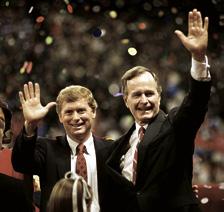



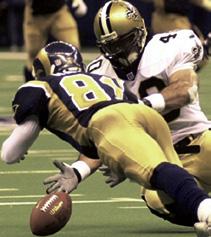

Super Bowl XXXI
The Green Bay Packers were being challenged by the New England Patriots in the second half of Super Bowl XXXI until Desmond Howard stole the show in the Superdome.
The Patriots cut the Packers lead to 27-21 after a Curtis Martin touchdown run, but Howard responded by returning the ensuing kickoff 99 yards to the house. Howard’s return was the final touchdown scored in a 35-21 Packers win. Patriots head coach Bill Parcells said that Howard’s touchdown “broke our back.” The former Heisman Trophy winner racked up 244 return yards in the game and became the first player to win Super Bowl MVP because of special teams contributions.
Eddie Robinson’s final game
For 56 years as Grambling’s head coach, Eddie Robinson set the standard for college football. His 408 career victories rank third all-time among college coaches. While the discussion leading up to the 1997 Bayou Classic was all about it being Robinson’s final game, it was the rival Southern Jaguars who came out victorious, 30-7.
The win secured the SWAC championship for the Jaguars and locked up their fifth straight Bayou Classic victory, but it was a difficult and emotional end for an incredible career for Robinson.
The legendary coach was inducted into the College Football Hall of Fame that year.
NCAA BCS title game
A sellout crowd of 79,280 was inside the Superdome to watch a pair of unbeaten teams, Florida State and Virginia Tech, face off in the BCS national title contest in the Sugar Bowl.
After the Seminoles jumped out to a 28-7 second-quarter lead, it was Michael Vick and the Hokies’ turn. Behind some big plays by the speedy QB, the Hokies rallied to a 29-28 lead to end the third quarter.
The Seminoles responded to score the final 18 points to claim a 46-29 victory. Vick helped the Hokies amass 503 yards of offense, the most ever by a losing team in the Sugar Bowl.
Saints win first playoff game
The Saints claimed their first playoff victory in franchise history with a 31-28 victory over the St. Louis Rams in the Superdome.
Saints QB Aaron Brooks threw for four touchdowns and wide receiver Willie Jackson tied an NFL postseason record with three touchdown catches, but the moment that Saints fans will remember the most was a game-clinching turnover on special teams.
Rams punt returner Az-Zahari Hakim fumbled the ball and veteran fullback Brian Milne was there to leap on the ball at the Rams’ 18-yard line and finish off a long-awaited moment in New Orleans.
The crowd of 64,900 went wild as the Saints ended a 34-year postseason drought.
Super Bowl XXXVI
The New England Patriots seemed to have bad voodoo placed on them during their Super Bowl trips to New Orleans until Tom Brady and Bill Belichick joined forces. The Patriots lost both of their prior New Orleans Super Bowl appearances by a combined 81 points, and they were underdogs against the St. Louis Rams.
The Patriots’ Super Bowl legacy was reversed after Brady’s fourth-quarter heroics set up a 48-yard field goal by Adam Vinatieri to send the Patriots home as Super Bowl champions.
It was the first of six Super Bowl wins for Brady, and it’s the Patriots’ only one in New Orleans.
BCS title game (LSU wins)
The return of LSU football as a national power was completed when the Tigers defense, led by Nick Saban, dominated the nation’s top offense in a 21-14 victory over Oklahoma. LSU held Heisman Trophy-winning quarterback Jason White to 13-of-37 passing, and Marcus Spears’ 20-yard pick-six gave the Tigers their final points and their first national championship (shared with USC) since 1958.
It began a special relationship between the state’s flagship school and the Superdome — LSU’s next two national titles, after the 2007 and 2019 seasons, also came via victories at the Dome.
Hurricane Katrina
The images are indelible. The Superdome, which was designed to withstand major storms, was used as a “shelter of last resort” in the aftermath of Hurricane Katrina, and no one who has seen the damaged roof, the crowds pressing to get in or the cots crowding the Dome floor will ever forget them.
As many as 30,000 people sheltered in the building, but it wasn’t exactly a safe haven; between the lack of air conditioning, flooding that reached the floor and sanitation issues, the Dome became unsanitary and dangerous, and eventually the crowds were evacuated elsewhere.
Saints return to dome
After Katrina, there was speculation the Superdome would never open again. But the state and SMG decided in early 2006 that it was worth renovating, and after spending the entire 2005 season elsewhere, the Saints returned home on Sept. 25, 2006. Even considering the Saints’ NFC championship victory and countless big victories of the Drew Brees-Sean Payton era, the “Rebirth” victory over the Falcons is one of the most emotional in the building’s history. Steve Gleason’s early blocked punt, now immortalized in a statue outside the Superdome, led the Saints to a 23-3 win that relaunched football fever in New Orleans.
LSU wins BCS title
A triple-overtime loss to Arkansas the day after Thanksgiving appeared to end LSU’s chances for the national championship, but chaos over the next eight days allowed LSU to slip into another national-title game at the Superdome. That included losses from No. 1 Missouri and No. 2 West Virginia, a serious flirtation between Les Miles and the Michigan job and an SEC championship victory over Tennessee.
The Tigers and MVP Matt Flynn took full advantage, using a 21-point second-quarter outburst to race past Ohio State 38-24 and win the program’s third national title, all of which were clinched with victories in New Orleans.
Saints win NFC title
“Pigs have flown. Hell has frozen over. The Saints are on their way to the Super Bowl!”
Thus spoke Jim Henderson, longtime play-by-play voice of the Saints as Garrett Hartley’s game-winning 40-yard field goal sailed through the uprights in the 2010 NFC championship game to defeat the Vikings.
The wild ending to a wild game set off intense celebrations in the Superdome and across New Orleans. The Saints finished the job two weeks later, defeating the Colts in Super Bowl XLIV and completing a journey that began with Drew Brees and Sean Payton joining the team after Hurricane Katrina.


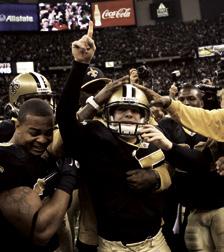
10 GREATEST
sports moments in Superdome history
JEFF DUNCAN | SPORTS COLUMNIST
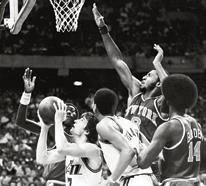
‘Pistol’ Pete pours in 68
February 25, 1977
Old-school basketball fans will never forget the night “Pistol” Pete Maravich lit up the New York Knicks for 68 points in the New Orleans Jazz’s 124-107 win.
Maravich riddled the Knicks with circus shot after circus shot en route to his career night. At the time, it was the most points a guard had ever scored in an NBA game. Forty-eight years later, it is still the 17th-highest scoring output in league history.
Maravich sank 26 of 43 shots from the field and went 16-of-19 from the free-throw line to break the previous high of 63 points set by Lakers guard Jerry West in 1962. Kobe Bryant now has the record for guards at 81 points, set in 2006. The Pistol scored 17 points in the first quarter, 14 in the second, 17 in the third and 20 in the fourth.
“There was no way we could stop him,” Knicks forward Bob McAdoo said that night. “The Pistol was hot tonight. He was really going off. The man beat us by himself.”
Maravich likely could have set the bar even higher, but he fouled out with 1:18 remaining. “I could have scored more,” Maravich said. “I missed a lot of easy shots early in the game.”

9
Roberto Duran utters
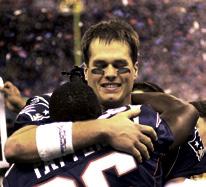
8
Billed
This Super Bowl, which was played in the patriotic backdrop as the first since the Sept. 11, 2001, terrorist attacks, was the beginning of the Patriots’ dynasty. 10
“No mas, no mas” vs. Sugar Ray Leonard Patriots upset “Greatest Show on Turf”
November 25, 1980
as “The Super Fight,” the rematch between Sugar Ray Leonard and Roberto Duran was one of the most anticipated title fights of the 1980s. But no one could have anticipated what transpired in the ring that night.
During the eighth round, Duran, the WBC welterweight champion, suddenly threw up his hands in surrender, uttering to the referee, “No mas, no mas. No more box,” after 2 minutes, 44 seconds had elapsed.
Leonard, who had lost the title to Duran in June, leaped in celebration, and the crowd erupted in disbelief after a fight with so much fanfare ended in surrender. Leonard won by technical knockout.
It marked the first time a champion had voluntarily surrendered his title since Sonny Liston quit to Muhammad Ali, then Cassius Clay, in 1964, claiming a shoulder injury.
Duran had held the lightweight championship for years and had lost only one decision in 72 bouts before taking the 147-pound title from Leonard June 20, 1980, in Montreal Duran later cited stomach cramps as the reason for his surrender but his manager Carlos Eleta said he was simply frustrated as Leonard consistently beat him to the punch and then taunted and mocked him throughout the fight. Leonard was ahead on all of the judges’ scorecards.
“Duran didn’t quit because of stomach cramps,” Eleta said. “He quit because he was embarrassed.”
TheFebruary 3, 2002
New England Patriots entered Super Bowl XXXVI as two-touchdown underdogs to the high-octane St. Louis Rams, a.k.a. “The Greatest Show on Turf.” But the upstart Patriots shocked the world, escaping with a 20-17 victory on a 48-yard field goal by Adam Vinatieri as time expired.
It was the biggest Super Bowl upset since the New York Jets upended the Baltimore Colts in 1969.
This was the coming-out party for Tom Brady, a former sixth-round draft pick who had taken over for injured starter Drew Bledsoe in midseason. Despite his inexperience, Brady calmly led the Patriots on an eight-play 53-yard drive with no timeouts to set up Vinatieri’s winning field goal. Brady was the MVP after completing 16 of 27 passes for 145 yards and one touchdown.
sports moments in Superdome history My list
10 GREATEST

‘Pistol’ Pete pours in 68
February 25, 1977
Old-school basketball fans will never forget the night “Pistol” Pete Maravich lit up the New York Knicks for 68 points in the New Orleans Jazz’s 124-107 win.
Maravich riddled the Knicks with circus shot after circus shot en route to his career night. At the time, it was the most points a guard had ever scored in an NBA game. Forty-eight years later, it is still the 17th-highest scoring output in league history.
Maravich sank 26 of 43 shots from the field and went 16-of-19 from the free-throw line to break the previous high of 63 points set by Lakers guard Jerry West in 1962. Kobe Bryant now has the record for guards at 81 points, set in 2006. The Pistol scored 17 points in the first quarter, 14 in the second, 17 in the third and 20 in the fourth.
“There was no way we could stop him,” Knicks forward Bob McAdoo said that night. “The Pistol was hot tonight. He was really going off. The man beat us by himself.”
Maravich likely could have set the bar even higher, but he fouled out with 1:18 remaining. “I could have scored more,” Maravich said. “I missed a lot of easy shots early in the game.”
JEFF DUNCAN | SPORTS COLUMNIST

9
Roberto Duran utters

8
Billed
This Super Bowl, which was played in the patriotic backdrop as the first since the Sept. 11, 2001, terrorist attacks, was the beginning of the Patriots’ dynasty. 10
“No mas, no mas” vs. Sugar Ray Leonard Patriots upset “Greatest Show on Turf”
November 25, 1980
as “The Super Fight,” the rematch between Sugar Ray Leonard and Roberto Duran was one of the most anticipated title fights of the 1980s. But no one could have anticipated what transpired in the ring that night.
During the eighth round, Duran, the WBC welterweight champion, suddenly threw up his hands in surrender, uttering to the referee, “No mas, no mas. No more box,” after 2 minutes, 44 seconds had elapsed.
Leonard, who had lost the title to Duran in June, leaped in celebration, and the crowd erupted in disbelief after a fight with so much fanfare ended in surrender. Leonard won by technical knockout.
It marked the first time a champion had voluntarily surrendered his title since Sonny Liston quit to Muhammad Ali, then Cassius Clay, in 1964, claiming a shoulder injury. Duran had held the lightweight championship for years and had lost only one decision in 72 bouts before taking the 147-pound title from Leonard June 20, 1980, in Montreal Duran later cited stomach cramps as the reason for his surrender but his manager Carlos Eleta said he was simply frustrated as Leonard consistently beat him to the punch and then taunted and mocked him throughout the fight. Leonard was ahead on all of the judges’ scorecards.
“Duran didn’t quit because of stomach cramps,” Eleta said. “He quit because he was embarrassed.”
TheFebruary 3, 2002
New England Patriots entered Super Bowl XXXVI as two-touchdown underdogs to the high-octane St. Louis Rams, a.k.a. “The Greatest Show on Turf.” But the upstart Patriots shocked the world, escaping with a 20-17 victory on a 48-yard field goal by Adam Vinatieri as time expired.
It was the biggest Super Bowl upset since the New York Jets upended the Baltimore Colts in 1969.
This was the coming-out party for Tom Brady, a former sixth-round draft pick who had taken over for injured starter Drew Bledsoe in midseason. Despite his inexperience, Brady calmly led the Patriots on an eight-play 53-yard drive with no timeouts to set up Vinatieri’s winning field goal. Brady was the MVP after completing 16 of 27 passes for 145 yards and one touchdown.
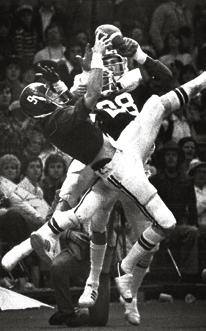
‘Bama’s goal-line stand denies Penn State
January 1, 1979
In the de facto national championship game between No. 1 Penn State and No. 2 Alabama, only inches separated the Nittany Lions from the goal line and perhaps their first national title. Trailing 14-7 and facing a fourth-and-goal at the Alabama goal line with six minutes to play, the top-ranked Nittany Lions (11-0) needed only a foot to score the potential game-tying or gamewinning touchdown.
But Alabama linebacker Barry Krauss met Penn State running back Mike Guman at the line scrimmage for no gain, preserving a dramatic 14-7 Crimson Tide win. Krauss was knocked unconscious and temporarily lost feeling in his extremities after the big hit, but he eventually ran off the field under his own power. Krauss’ tackle is considered the most dramatic goal-line stop in college football history.
The stop prevented Penn State and longtime head coach Joe Paterno from winning their first national title.
Bama’s Bear Bryant, meanwhile, won his fifth national title.



5 6
Brees breaks NFL’s all-time passing record
October 8, 2018
Withthe nation watching and a sellout crowd anticipating history, Drew Brees delivered one of the hallmark performances of his Hall of Fame career, passing for 363 passing yards in a rout of Washington and breaking the NFL’s career passing record.
Brees’ 62-yard touchdown pass to Tre’Quan Smith just before halftime pushed him past Peyton Manning in the NFL record book and delivered a wow moment for the national viewing audience on Monday Night Football.
The game was interrupted for a ceremonial presentation by Pro Football Hall of Fame President David Baker on the Saints sideline and a recorded congratulatory speech by Manning displayed on the video board. Brees shared an emotional moment with his family on the sideline, telling his four children, “You can accomplish anything in life if you are willing to work for it.”
On the game’s biggest regular-season stage against the league’s top-ranked pass defense, Brees recorded the fifthbest passer efficiency rating (153.2) of his 18-year career.
“I don’t think it could have happened in any better fashion than it did,” an emotional Brees said afterward.
This game had it all: drama, execution and impact. An unforgettable moment from a legendary career. Classic Drew Brees.
Ali whips Spinks in Battle of New Orleans
September 15, 1978
TheBattle of New Orleans” was the first great fight in Superdome history and attracted a crowd of 63,382, at the time, the largest ever for an indoor boxing match. ABC broadcast the fight live to a national audience of 90 million views, another record. Muhammad Ali reclaimed the WBA heavyweight crown he had lost to Leon Spinks months earlier by winning a unanimous decision in 15 rounds over the 25-year-old slugger.
Ali became the first man to win the heavyweight title three times in what was supposed to be his final fight. He returned to the ring a couple of years later for a pair of fights.
The extravaganza attracted an array of stars. Sylvester Stallone, Liza Minnelli, Kris Kristofferson and Lorne Greene sat ringside and were among the crowd of 70,000. Former heavyweight champion Joe Frazier sang the national anthem before the fight.

Pigs fly as Saints advance to first Super Bowl
January 24, 2010

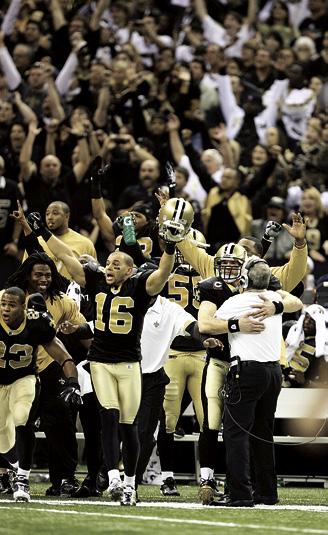
Infootball terms, there’s never been a more important Saints game in the Superdome than the 2009 NFC Championship Game.
Garrett Hartley’s 40-yard field goal capped a nerve-racking overtime victory that propelled the Saints to Super Bowl XLIV and touched off a massive celebration throughout the city.
The Vikings outplayed the Saints for four quarters but could not overcome five turnovers, including one by Brett Favre in the waning minutes of regulation that prevented a potential game-winning field goal attempt.
In many ways, this was more important than the Super Bowl. When Hartley’s kick split the uprights, sending the Saints to the Super Bowl for the first time in franchise history, the outpouring of joy, relief and shock inside the building was unprecedented. Pigs had flown. Hell had frozen over. They were going to the Super Bowl. Everything after that moment was lagniappe for the Saints and their loyal fans. The Saints had finally gotten over the hump.

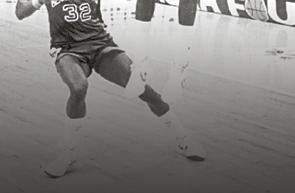
Michael
Jordan delivers title to Carolina
March 29, 1982

Jordan signaled his emergence as a future superstar with a gamewinning jump shot to beat Georgetown 63-62 in the 1981-1982 national championship game. The precocious freshman upstaged upper-class stars James Worthy, Sam Perkins and Patrick Ewing with his heroics.
Jordan’s game-winner ended the long suffering of legendary North Carolina coach Dean Smith, who had a reputation as the coach who couldn’t win the big one.
With the Tar Heels trailing by one point, Jordan sank a baseline jumper with 15 seconds remaining to give North Carolina a 63-62 lead, before a crowd of 61,612. The Hoyas still had a chance to win, but Fred Brown inadvertently passed the ball to Worthy on the ensuing possession with seven seconds left. Smith, who designed the play for Jordan against Georgetown’s 1-3-1 zone, won his first national title after coming up empty in six previous Final Four trips. North Carolina won its first national championship since 1957.


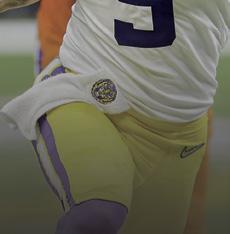
TheLSU punctuates perfect season
January 13, 2020 2

Tigers punctuated their perfect season with an exclamation point. Their 42-25 rout of Clemson in the CFP national championship game capped the greatest season in LSU history and one of the most dominant campaigns in college football annals.
A partisan LSU crowd watched Joe Burrow riddle the ACC champions’ defense for 463 passing yards and five touchdowns as the Tigers roared back from an early 17-7 deficit. Star receivers Ja’Marr Chase and Justin Jefferson each caught touchdown passes to cap their college careers before moving on to NFL stardom. Chase finished with nine catches for 221 yards.
Under a shower of sparkling white, gold and purple confetti, Burrow raised the CFP championship trophy toward the Superdome roof to a raucous celebration from the sellout crowd.
“This is what I wanted to do from the time I was 5 years old, was hoist this trophy,” Burrow said. “We weren’t going to let someone come in here and steal this from us in our home state.”
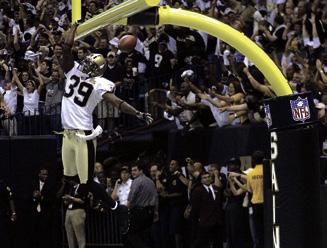
Rebirth for a city and its team
September 25, 2006

Themagical and emotional reopening of the Superdome after Hurricane Katrina will forever be the most meaningful moment in Superdome history. It was essentially a celebration of the Dome itself and amounted to a Super Bowl for locals. A sellout crowd packed the stadium, many of the fans with signs celebrating its reopening.
Former President George H.W. Bush, Gov. Kathleen Blanco, NFL Commissioner Paul Tagliabue, Snoop Dogg and Spike Lee were among the VIPs and luminaries in attendance. The NFL used its most powerful platform – Monday Night Football – to showcase the city’s recovery and the team’s impact on the region and lured a Super Bowl-worthy musical lineup – U2, Green Day, the Goo Goo Dolls and popular local acts Trombone Shorty, Irma Thomas, Allen Toussaint, Kermit Ruffins and the Rebirth Brass Band – to perform.
The emotion and electricity inside the Dome were palpable at kickoff, and the energy detonated when Steve Gleason blocked Michael Koenen’s punt 90 seconds into the game, and Curtis Deloatch scooped it up for a touchdown. By most accounts, the crowd’s emotional reaction to the play generated the loudest noise ever heard in the Superdome. The Falcons never had a chance. The Saints rolled a dominant 23-3 win.
Gleason’s play was a cathartic moment for Saints fans and the city of New Orleans, one that has since been commemorated with a bronze statue on the Superdome apron. 1


